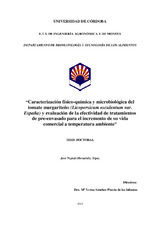Mostrar el registro sencillo del ítem
Caracterización físico-química y microbiológica del tomate margariteño (Licopersicum esculentum var. España) y evaluación de la efectividad de tratamientos de pre-envasado para el incremento de su vida comercial a temperatura ambiente
| dc.contributor.advisor | Sánchez, María-Teresa | |
| dc.contributor.author | Hernández Yépez, José Neptalí | |
| dc.date.accessioned | 2013-05-02T11:45:55Z | |
| dc.date.available | 2013-05-02T11:45:55Z | |
| dc.date.issued | 2013 | |
| dc.identifier.uri | http://hdl.handle.net/10396/9925 | |
| dc.description.abstract | El cultivo del tomate margariteño en el Oriente de Venezuela es muy rentable debido a su alto rendimiento y a la demanda que tiene en los Estados de Anzoátegui, Bolívar, Sucre, Monagas y Nueva Esparta. Dicho tomate puede ser consumido en fresco y también puede ser utilizado para la preparación de salsas, guisos y sopas. Sin embargo, el tomate es un fruto muy perecedero que sufre deterioro rápidamente, lo que disminuye su tiempo de vida útil. La aplicación en tomates de tratamientos poscosecha destinados a preservar su calidad y alargar su vida comercial resulta ser decisiva. Debido a lo anteriormente expuesto, y considerando la alta demanda de tomates margariteños dentro del mercado venezolano, se ha considerado de gran importancia el realizar un Trabajo de Investigación destinado en primer lugar, a la caracterización de este producto venezolano, para posteriormente, evaluar el efecto de la aplicación de distintos tratamientos poscosecha (inmersión en agua caliente, lavado en agua clorada y encerrado) previos al envasado comercial, sobre la calidad físico-química, microbiológica y sensorial del tomate margariteño conservado a temperatura ambiente, con la finalidad de proponer alternativas tecnológicas de bajo coste, destinadas a incrementar la vida comercial de este producto, manteniendo sus estándares de calidad iniciales Las características físicas de la calidad externa determinadas en el tomate margariteño var. “España” en estado de madurez rojo, permiten afirmar que se trata de un tomate de tamaño grande, con forma achatada y una coloración uniforme roja intensa. La firmeza que dicho tomate presenta en el estado de maduración rojo-maduro posibilita su transporte a granel sin que el producto sufra mermas de calidad durante el mismo. Los valores de los parámetros químicos de calidad externa exhibidos por el tomate margariteño en estado rojo-maduro ponen de manifiesto la alta calidad del mismo, y su idoneidad para el consumo en fresco al tratarse de un tomate equilibrado en cuanto a su sabor y flavor... | es_ES |
| dc.description.abstract | The Margariteño tomato is a highly profitable crop in eastern Venezuela, due to high yields and a strong demand in the States of Anzoátegui, Bolívar, Sucre, Monagas and Nueva Esparta. It can be consumed fresh but also used in making sauces, stews and soups. However, tomato is highly perishable vegetable that suffer important quality changes after harvesting. Tomato ripening is associated with a number of variations in chemical composition, cellular structure, and internal structure of the fruit. Different post-harvest treatments are generally used to maintain its quality and to extend its shelf life. This study sought to characterize the Margariteño tomato and to evaluate the effect of three treatments applied prior to commercial packaging (immersion in hot water, washing in chlorinated water, and waxing) on the physical/chemical, microbiological and sensorial quality of Margariteño tomatoes kept at room temperature, with a view to identifying low-cost technological alternatives for extending their shelf life without impairing quality attributes. The study of the physical characteristics of the Margariteño tomato (red maturity state) showed that the Margariteño tomato can be considered as a great size tomato, with a flat shape and an intense and uniform red coloration. The firmness of this tomato in this maturity state makes possible its bulk transportation without quality loss. The chemical characteristics of this tomato pointed out its high quality and its convenience for fresh consumption due to its equilibrated taste and flavor. Control tomatoes displayed evident signs of deterioration (softening, exudation and wrinkled surface) by 13 days’ storage; these signs were observed in tomatoes immersed in hot water tomatoes and tomatoes washed in chlorinated water at 15 days, and in waxed tomatoes at 21 days. In all cases, skin color darkened during post-harvest storage, although in waxed and chlorine-treated tomatoes an increase in yellow coloring was observed over the first 6 days of storage. Titratable acidity and maximum shear... | es_ES |
| dc.format.mimetype | application/pdf | es_ES |
| dc.language.iso | spa | es_ES |
| dc.publisher | Universidad de Córdoba, Servicio de Publicaciones | es_ES |
| dc.rights | https://creativecommons.org/licenses/by-nc-nd/4.0/ | es_ES |
| dc.subject | Tomate margariteño | es_ES |
| dc.subject | Venezuela | es_ES |
| dc.subject | Calidad | es_ES |
| dc.subject | Conservación poscosecha | es_ES |
| dc.subject | Envasado | es_ES |
| dc.subject | Almacenamiento | es_ES |
| dc.subject | Pre-envasado | es_ES |
| dc.subject | Calidad físico-química | es_ES |
| dc.subject | Calidad microbiológica | es_ES |
| dc.title | Caracterización físico-química y microbiológica del tomate margariteño (Licopersicum esculentum var. España) y evaluación de la efectividad de tratamientos de pre-envasado para el incremento de su vida comercial a temperatura ambiente | es_ES |
| dc.type | info:eu-repo/semantics/doctoralThesis | es_ES |
| dc.rights.accessRights | info:eu-repo/semantics/openAccess | es_ES |

